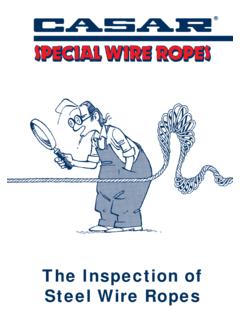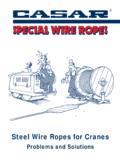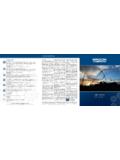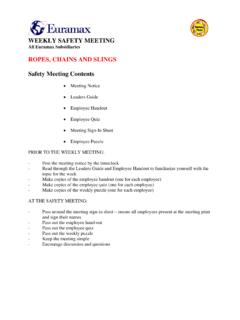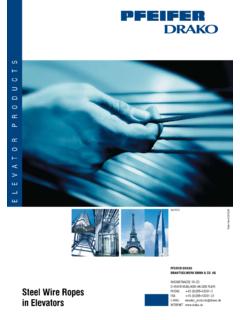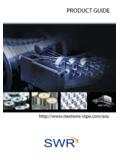Transcription of Tension-torsion fatigue effects in wire ropes - BGISL
1 OIPEEC Bulletin 77 1999 1 Chaplin, G. Rebel and Ridge ODN Reading rope Research, University of Reading, United Kingdom Tension-torsion fatigue effects in wire ropes Summary As oil exploration and production moves to deeper waters, there is increasing reliance on moored floating structures and consequently anchoring systems are becoming more complex. This complexity inevitably translates also to more difficult installation procedures. Some components (especially stranded wire ropes ), used both as part of permanent mooring systems and in the raising and lowering of other components, have a tendency to untwist under tensile load. This tendency, if unrestrained can transfer rotation into other parts of the mooring system which are more sensitive to twisting.
2 Dynamic rotations associated with fluctuating tensions are also a potential cause for concern. This article addresses these concerns and in particular describes the results of recent research which has disturbing implications for the reliability of mooring lines where stranded wire rope is allowed to twist without restraint. 1 Introduction and background Over the past twenty years the rope Research group at Reading University has been active in high quality research addressing real problems in rope applications. One field of application has dominated the research : the use of ropes for mooring floating offshore structures. The group has also been involved in other rope applications, notably mine hoisting in very deep shafts, diving bell hoisting and the broader issues of rope safety and inspection.
3 In 1995, in an attempt to establish a higher degree of continuity in the funding of Reading s work, a rope Research Club was established with direct funding from industry. This has been supplemented by further government support from the UK Engineering and Physical Sciences Research Council. The original two and a half year programme focussed on the influence of damage and rope quality on fatigue endurance, as well as developing Reading s continuing interest in fibre rope by looking at the feasibility of condition monitoring systems. The rope Research Club has now entered into a second phase with a new programme of work that includes a study of rope torsional behaviour and the related interactions between rope and other tension members that are used in mooring lines.
4 Any structural component manufactured by twisting elements together, be they wires or fibres, has a tendency to untwist under tensile load unless restrained from doing so (figure 1). In some situations, this tendency may just be an inconvenience that makes it difficult to handle the component (be it rope or yarn); or sometimes that inconvenience can become a problem, as in the cabling (or twisting together) of two falls of rope to a pulley block from the jib of a crane. In other cases the effects can become much more serious, as in the hockling (or kinking) of a spiral strand mooring line. OIPEEC Bulletin 77 - 1999 2 Figure 1 : Single layer helically wound tension members will tend to unwind or unlay when they are loaded without torsional restraint.
5 rope manufacturers have developed various rope constructions to reduce the tendency to untwist like the 34 LR multi-strand shown in figure 2. However these torque balanced ropes can never be perfectly balanced and, more importantly, are much more sensitive than their six-strand counterparts to any twist that is imposed. Hockling involves the formation of a loop when rope under torsion has only a modest tensile load applied. On re-tensioning the consequences can be quite devastating, involving major loss of tensile strength, and especially of fatigue performance (figure 3). This kind of problem has been encountered during installation of mooring lines for deep water production facilities. In at least one case that has been investigated, Chaplin (1998) explains that the problem was almost certainly caused in the first instance by a six-stranded wire rope installation pendant transferring twist to a chain, that was subsequently passed to a spiral strand when the assembly was tensioned.
6 On relaxing the tension in the spiral strand it hockled and was then permanently damaged when re-tensioned (figure 4). This process was repeated for all the mooring lines of the system and all spiral strand elements had to be scrapped. In this case the problems could have been prevented if the untwisting rotation of the work wire was not transferred to the chain. One way of decoupling the two would be to use a low friction swivel during installation. Gibson (1990) discussed examples of typical marine applications that can cause rope rotation and examined the twist sensitivity of various rope constructions. For example,six strandright hand layropeRotation offree endcausesunlaying ofrope underloadFigure 2 : Example of multi-strand, low rotation rope construction, 34 LR.
7 OIPEEC Bulletin 77 1999 3 Another rope application where twisting has long been recognised as a cause for concern, and has been linked to the mechanisms of degradation, is mine hoisting. The shafts of gold mines in South Africa are the deepest in the world (up to 3200 m in a single lift) and the ropes most commonly used for winding onto the large diameter drums favoured for the application, have six triangular strands over a fibre core. Furthermore, to minimise wear on sheave and drum, the strands have the same helical sense as the rope (Lang s lay). This construction has an even greater tendency to untwist than the ordinary lay ropes that are used for traditional work wires and both temporary and permanent moorings in the offshore industry.
8 The amount of rotation, static and dynamic, that occurs in these mine hoist ropes , apparently without detriment, is far more than what would intuitively be expected even though the lower end is restrained from rotation by the conveyance travelling in steel guides. Briefly, the reason for the twisting is that due to its own weight the rope is subject to a progressively increasing tension from the lowest point to the surface, whilst the torque must be constant: equilibrium is achieved by counter-twisting of the top with respect to the bottom. To understand these effects in mine hoist ropes considerable effort has been put into measuring and modelling the interactions between torque, tension and the degree of rotation. The rope Research group at Reading is applying similar technology to mooring lines, but the situation is compounded because in addition to wire ropes , Figure 3 : Severe individual strand hockling in an 8 strand work wire .
9 Figure 4 : Permanently damaged spiral strand mooring line. OIPEEC Bulletin 77 - 1999 4 chains and now fibre ropes are used in series in composite lines. So in order to predict behaviour of a wire rope in a mooring line it is essential to understand the torque / tension response of the other components too, however well they might be torque balanced . Measurements have therefore been taking place in the laboratory of the characteristics of all classes of mooring line components including wire ropes of various constructions, chain and fibre rope . Eventually it is intended to develop a model to predict interactions between components in a line, as well as interactions during handling and installation procedures.
10 One example of the kind of information emerging from this work is that chain, has a torsional stiffness that increases in a highly non-linear way with tension . It also exhibits a high degree of hysteresis when subject to torsional oscillation, but at very low tension has almost zero torsional stiffness. Perhaps none of this is surprising, in qualitative terms, but quantification and modelling of such behaviour has not been attempted before. The question which arises as a result of this work is how much this twisting actually matters. It has already been found that rope twisting is increasingly a problem with increasing water depth in installation processes, but what about the effect when rope and chain are combined in a composite mooring line?

